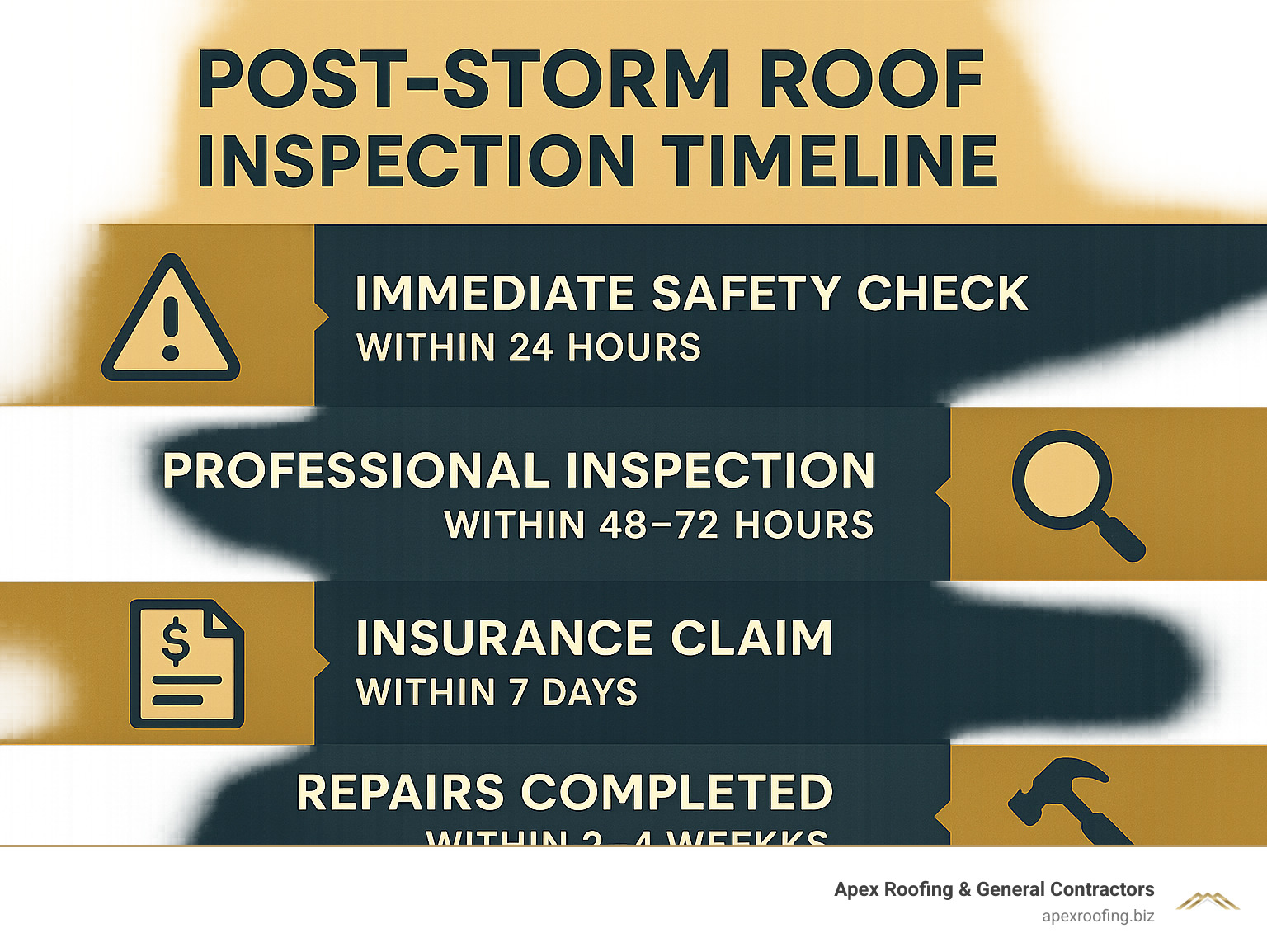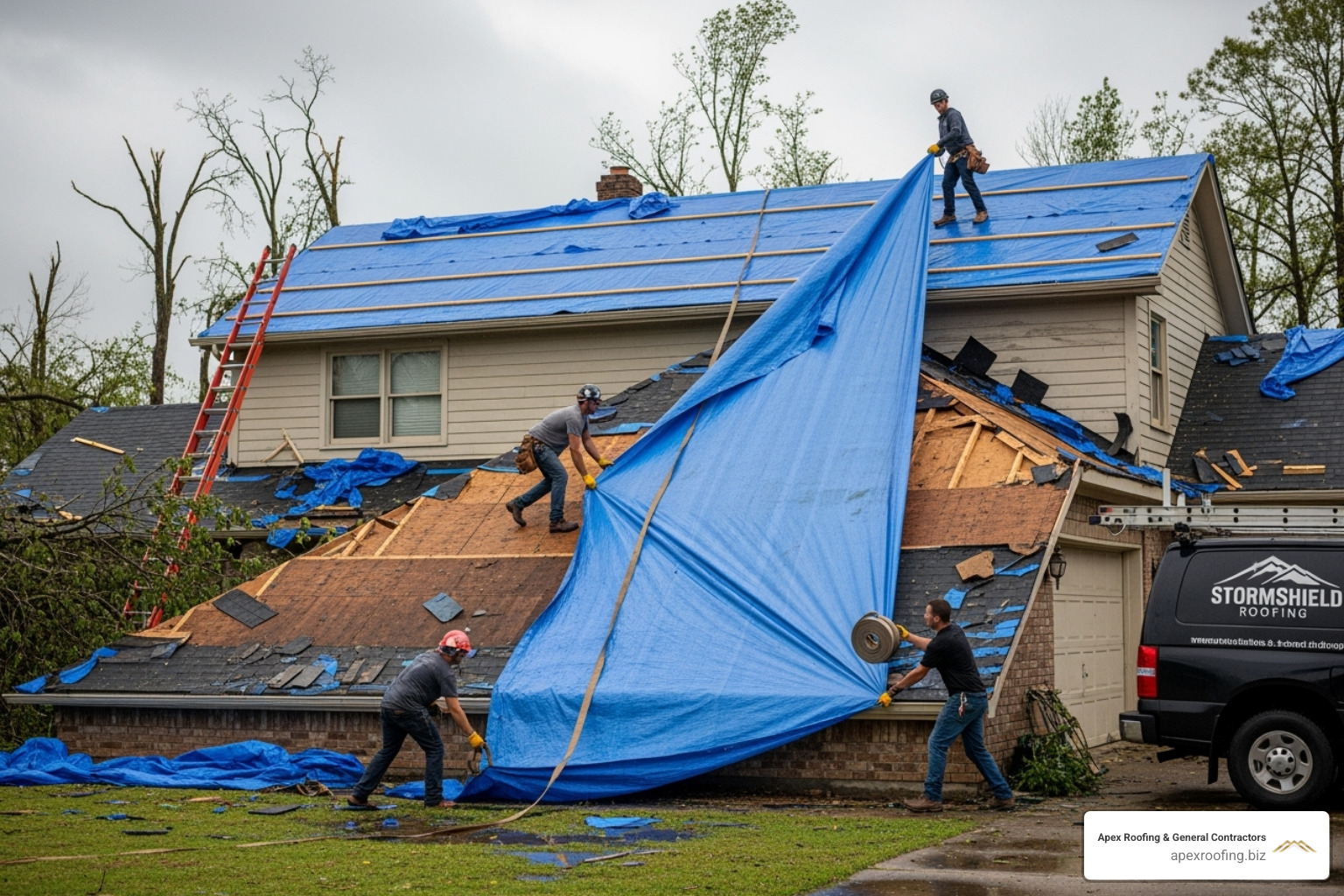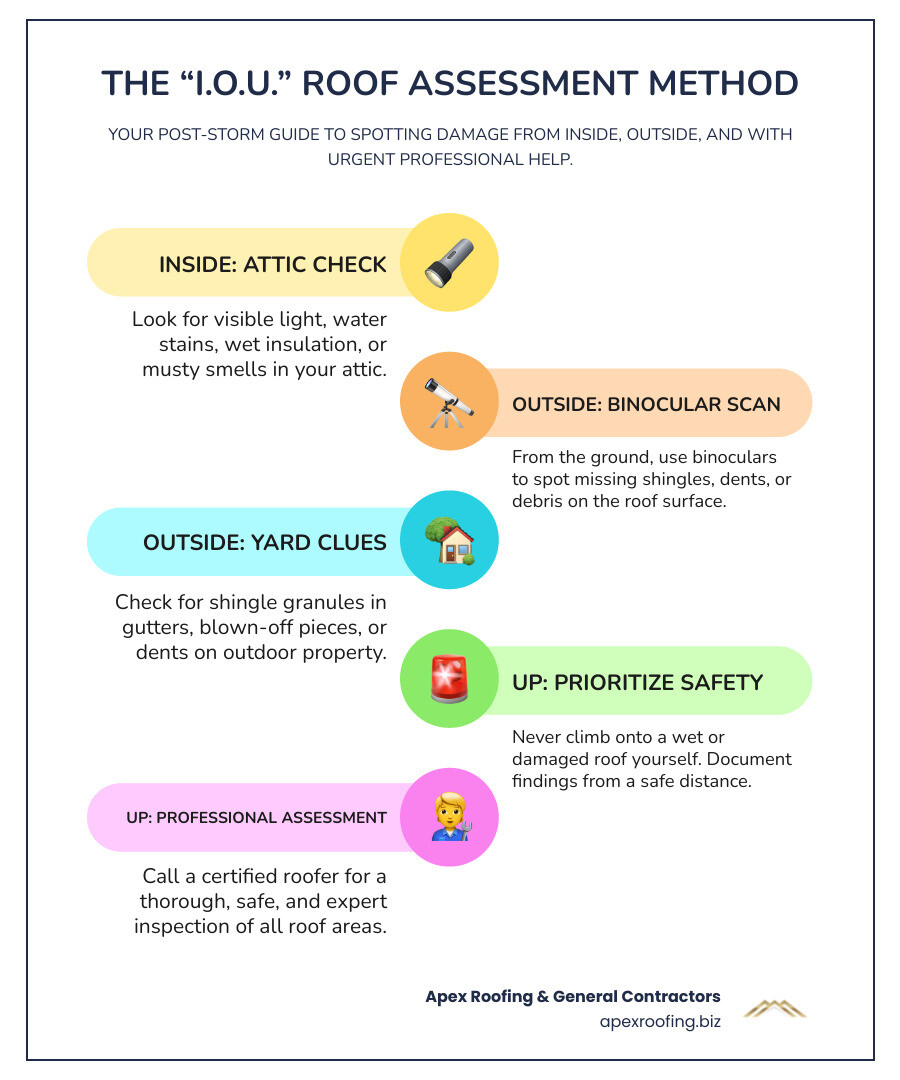When Storms Strike: Your Roof’s Fight for Survival
Storm damage roof repair becomes an urgent priority when severe weather hits San Antonio. Your roof is the first line of defense, but even the strongest materials can fail against high winds, hail, and debris. When a storm strikes, you need reliable San Antonio roofing contractors who can respond quickly. The simple truth is that acting fast can save you from more extensive and costly damage later. Even one missing shingle could be a sign of a bigger problem that qualifies for a full roof replacement through your insurance.
Most homeowner policies cover storm damage, but only if you document it properly and act swiftly. Knowing what to look for and taking the right steps immediately after a storm is key. At Apex Roofing & General Contractors, we’ve helped countless homeowners steer storm damage since 2022. Our team provides emergency response and comprehensive residential roofing services, earning an A+ rating from the Better Business Bureau for our quality craftsmanship and transparent communication.
If you suspect storm damage, don’t wait. Call (726) 727-7663 for a free inspection and estimate today.

Storm Damage 101: Know the Enemy
Understanding the forces attacking your roof is crucial for effective storm damage roof repair. Severe weather in San Antonio is a multi-pronged assault, and knowing how each element causes damage helps you spot warning signs before they become disasters.
- Wind Uplift: Strong gusts get under shingles, lifting and peeling them away. This can create a domino effect, stripping entire sections of your roof.
- Hail Impact: Frozen projectiles traveling up to 100 mph act like tiny hammers, stripping away protective granules and making shingles vulnerable to leaks.
- Flying Debris: Tree branches and other loose items become missiles that can puncture your roof, crack tiles, or tear flashing.
- Ice and Snow: Heavy accumulation can cause structural stress. Ice dams form when melting snow refreezes, forcing water back under your shingles.
- Lightning Strikes: Though less common, lightning can cause burn marks, structural cracks, and even fires.
Different materials show damage differently. Asphalt shingles lose granules or crack, metal roofs dent, and tile roofs can shatter. The real danger often appears inside as water stains on ceilings, peeling paint, or musty odors, indicating a breach. For more on how severe weather develops, see the latest research on U.S. thunderstorms from the National Severe Storms Laboratory.
Wind, Hail, Water—How Each Attacks
These forces work together to compromise your roof. Wind creates an opening by lifting shingles or flashing. Hail then pummels the exposed and surrounding areas, knocking off protective granules. Finally, water exploits these weaknesses, seeping into your home to rot wood, soak insulation, and promote mold growth. Clogged gutters full of storm debris only worsen the problem by causing water to overflow and seep under the eaves.
Spot-It-Early Checklist
After a storm, perform a safe inspection from the ground. Never climb on a wet or damaged roof.
- Binocular Scan: Walk around your property and use binoculars to look for missing shingles, dented gutters or vents, and visible punctures.
- Attic Flashlight Test: In your attic, turn off the lights and look for any daylight penetrating the roof deck. Also, check for water stains, wet insulation, or musty smells.
- Yard Debris Clues: Look for shingle granules in your gutters or at downspout outlets—a key sign of hail damage. Pieces of roofing material in your yard confirm significant damage.
If you spot any of these signs, it’s time to call professionals. Catching damage early can be the difference between a simple repair and a full replacement. Call (726) 727-7663 today to schedule your free inspection.
One Simple Way to Fix Storm Damage on Your Roof (storm damage roof repair)
When your roof takes a beating, the single most effective storm damage roof repair strategy is to act fast with professional help. This one decision can prevent a minor issue from becoming a catastrophe.
Getting a professional on-site immediately is critical. What seems like a small problem from the ground often indicates more widespread damage that only an expert can identify.

Same-day emergency tarping can save you thousands in water damage while you arrange permanent repairs. Our team documents all damage during the initial visit, creating the evidence your insurer needs to approve a claim. We handle the dangerous work on the roof so you can stay safe on the ground. Best of all, the initial inspection and estimate are completely free.

The “I.O.U.” method—Inside, Outside, Up-the-ladder—is a good starting point for your own assessment before the pros arrive.
Immediate Storm Damage Roof Repair Steps
Your actions in the hours after a storm are crucial. Quick thinking can prevent a major headache.
- Stay off the roof. We can’t stress this enough. Damaged roofs are unpredictable and dangerous.
- Document everything. Take timestamped photos from every safe angle. Capture missing shingles, dented gutters, and any interior water damage.
- Get emergency tarping. For active leaks or holes, a professionally installed tarp is the best temporary fix to prevent water from pouring into your home.
- Address interior water. Use buckets and towels to manage leaks. Standing water leads to mold growth quickly in our humid climate.
When Professional Storm Damage Roof Repair Is Vital
Some signs demand immediate professional help. If you see structural sagging, damage on multiple roof slopes, or exposed roof decking, your home’s protective barrier is severely compromised. Widespread shingle loss or damaged flashing around chimneys and vents also requires an expert assessment. Delaying professional repairs almost always costs more as water damage spreads and structural issues worsen. For help with these critical issues, our storm damage repair team is ready to respond.
Material-Specific Fixes
Repair approaches vary by roofing material. Asphalt shingle repairs may involve replacing individual shingles or entire sections. Metal roof repairs focus on addressing dents and resealing panels. Tile and wood shake roofs require careful replacement of individual pieces to maintain a weatherproof seal. Flat roof membrane repairs use patches or heat welding to restore the waterproof barrier.
| Repair Type | Cost Range | Benefit |
|---|---|---|
| Emergency Tarping | Low | Immediate protection, prevents further damage |
| Individual Shingle/Tile | Low-Moderate | Extends roof life in damaged areas |
| Section Replacement | Moderate-High | Restores integrity to storm-affected areas |
| Full Replacement | High | Complete protection, often insurance-covered |
Ready to protect your home? Call (726) 727-7663 for your free storm damage inspection and estimate today.
Navigating Insurance Claims Without the Headache
Dealing with storm damage roof repair is stressful enough without insurance paperwork. The good news is most homeowners insurance covers damage from wind and hail. Understanding the process and having the right documents are key to a smooth claim.
Your insurer will assign an adjuster to assess the damage and determine your payout. Your coverage type significantly impacts this:
- Actual Cash Value (ACV): Pays the depreciated value of your roof. The older the roof, the less you get, often leaving you with out-of-pocket expenses.
- Replacement Cost Value (RCV): Covers the full cost to replace your roof with similar materials. You’ll get an initial ACV payment, and the rest (recoverable depreciation) is paid after the work is complete.
Your deductible is what you pay before insurance kicks in. Also, be mindful of claim deadlines, as most policies require you to report damage within a year. For additional help, FEMA’s disaster assistance programs can offer support in federally declared disaster areas.
Must-Have Documentation Package
A successful claim depends on clear evidence. Your documentation package should include:
- Date-stamped photos and videos: Capture wide shots and close-ups of all exterior and interior damage.
- A detailed contractor estimate: Our estimates break down all material and labor costs, giving the adjuster a clear scope of work.
- An official weather report: This validates that the damage was caused by a specific storm.
- Receipts for temporary fixes: Keep records of expenses like emergency tarping for reimbursement.
Pro Tips to Maximize Payout
After helping countless San Antonio homeowners, we’ve learned what works.
- Have a professional present during the adjuster’s inspection. An adjuster isn’t a roofer and may miss hidden damage. We can point out issues that might otherwise go unnoticed, ensuring a fair assessment.
- Supplement the scope. If the initial estimate misses necessary work, we help you submit supplemental claims to ensure full coverage.
- Avoid storm-chaser scams. After a storm, out-of-town contractors often appear, make big promises, and then disappear after receiving payment, leaving you with shoddy work. Always choose an established, local contractor.
We’ve built our reputation on quality work and honest dealing. You have rights as a policyholder, so don’t accept a lowball offer without a second opinion from a qualified roofer.
Prevent, Prepare, Prosper: Future-Proofing Your Roof
The best storm damage roof repair is the one you never have to make. While you can’t control the weather, you can improve your roof’s resilience through smart preparation and maintenance.
- Impact-Rated Shingles: Class 4 shingles are designed to withstand hail and may earn you a discount on your insurance premium.
- Proper Attic Ventilation: Good airflow prevents ice dams in winter and reduces heat buildup in summer, which can prematurely age your roofing materials.
- Clean Gutters and Trimmed Trees: Clogged gutters cause water to back up and seep into your home’s structure. Overhanging branches can become battering rams during a storm.
- Annual Professional Check-ups: A yearly inspection can catch minor issues like loose flashing or granule loss before they become expensive emergencies, especially before storm season.
For homeowners seeking maximum protection, upgrading to fortified roof standards creates a home built to withstand severe weather. While a larger upfront investment, it provides long-term peace of mind.
DIY Upkeep vs Pro Maintenance
Knowing when to DIY and when to call a professional is key to roof maintenance.
What you can do:
- Regularly clean your gutters (with proper ladder safety).
- Conduct visual inspections from the ground with binoculars.
- Monitor your attic and ceilings for any signs of leaks.
What to leave to the pros:
- Inspecting flashing around chimneys, vents, and skylights.
- Identifying subtle material fatigue or loosened fasteners.
- Performing any repairs, even replacing a single shingle, to ensure it’s done correctly and safely.
We understand that unexpected repairs can be a financial strain, which is why we offer financing options. Our team operates with full transparency and adheres to all local building codes, as detailed on our professional licensing page. A little prevention goes a long way. Call (726) 727-7663 for your free inspection and let’s ensure your roof is ready for Texas weather.
Frequently Asked Questions about Storm Damage Roof Repair
After a storm, homeowners have urgent questions. Here are straightforward answers to the most common concerns about storm damage roof repair.
What signs mean I need storm damage roof repair right now?
Certain signs require immediate action to prevent further damage. Call a professional right away if you see:
- Active Leaks: Water dripping inside your home or spreading stains on your ceiling.
- Visible Holes or Punctures: Any opening that exposes your home’s interior to the elements.
- Extensive Missing Shingles: Large patches of missing shingles that leave your roof deck vulnerable.
- Sagging Rooflines: Any dip or change in your roof’s shape, which could indicate a serious structural problem.
- Large Debris Impacts: Fallen branches or other heavy objects can cause hidden damage that will lead to future leaks.
How long do I have to file an insurance claim after a storm?
Most insurance policies give you one full year from the date of the storm to file a claim. However, it is always best to act quickly. Filing within a few weeks makes it easier to connect the damage to a specific storm, which strengthens your claim. Delaying can create complications, as your insurer might question whether the damage was caused by the original storm or a later event. Prompt reporting shows you are proactive and helps prevent normal wear and tear from being confused with storm damage.
Can I do temporary repairs myself without voiding my warranty?
Generally, making temporary protective repairs like tarping a leak will not void your manufacturer’s warranty. In fact, preventing further water damage can help preserve your warranty. However, a poorly installed tarp can sometimes cause more harm by trapping moisture or coming loose and damaging other parts of the roof.
Your workmanship warranty from the original installer may have stricter rules, often requiring any work to be done by a qualified professional. The safest approach is to have a professional handle even temporary fixes. We have the right equipment and experience to secure your roof safely and effectively.
If you need immediate help, call (726) 727-7663 for a free inspection and emergency services.
Conclusion
When storms hit San Antonio, your roof bears the brunt. But storm damage roof repair doesn’t have to be a prolonged, costly headache. The solution is to know the signs, act fast, and partner with a professional team that is committed to protecting your home.

At Apex Roofing & General Contractors, we’ve seen everything from hail-pocked shingles to entire roof sections peeled back by wind. We’ve learned that homeowners who recover fastest are those who call for help immediately. We are your certified local experts, dedicated to restoring your home’s safety. From Helotes to Alamo Heights, we are proud to serve the greater San Antonio area, often arriving within hours of a storm.
Most storm damage is covered by insurance when documented correctly. We guide homeowners through the claims process, helping them secure the coverage they deserve. Whether you need emergency tarping or a complete overhaul, we provide transparent communication and quality work that has earned us an A+ BBB rating.
Don’t let a small problem grow. We provide free inspections so you know exactly what you’re dealing with. Call (726) 727-7663 today to schedule your no-obligation estimate and get your peace of mind back. For more details on our services, learn about our storm damage repair process.



